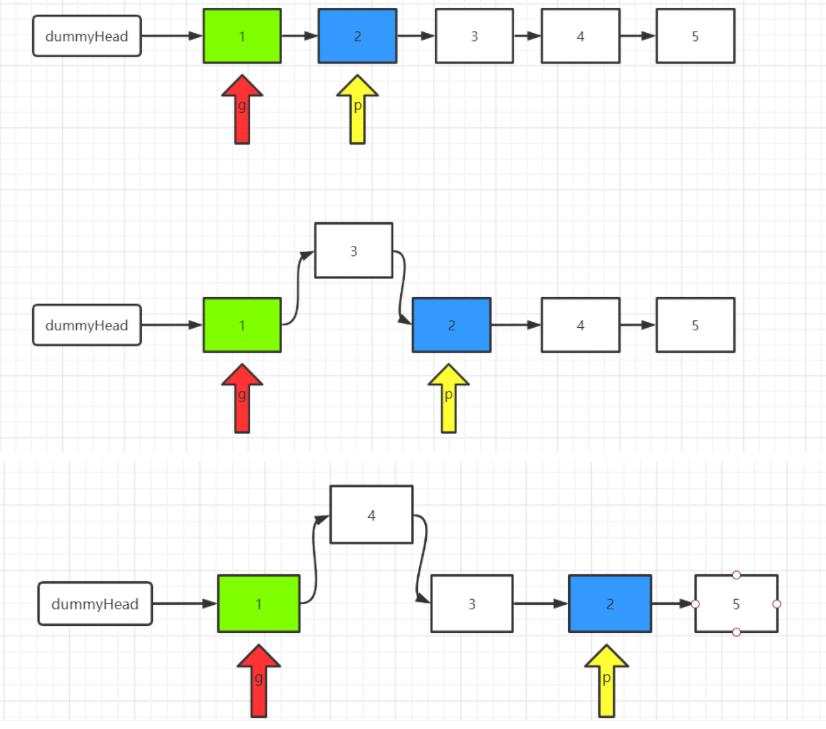一、
顺序结构:这里主要指的是数组或字符串。
一、链表的基本操作
| LeetCode题目 | 相关题目类型 | 相关链接 |
|---|---|---|
| 707 | 设计链表(中等难度) | https://leetcode-cn.com/problems/design-linked-list/ |
在链表中添加或删除元素时,记得修改链表长度;
代码:csdn博客:力扣 707. 设计链表 链表
1
2
3
4
5
6
7
8
9
10
11
12
13
14
15
16
17
18
19
20
21
22
23
24
25
26
27
28
29
30
31
32
33
34
35
36
37
38
39
40
41
42
43
44
45
46
47
48
49
50
51
52
53
54
55
56
57
58
59
60
61
62
63
64
65
66
67
68
69
70
71
72
73
74
75
76
77
78
79
80
81
82
83
84
85
86
87
88
89
90
91
92
93
94
95
96
97
98
99
100
class MyLinkedList {
public:
/** 初始化数据结构 */
MyLinkedList():head(new node()),tail(head),size(0) {}
/** 得到链表中第index个结点的值,index小于0或大于链表长度(链表的index从0开始),返回-1 */
int get(int index) {
if(index>=size||index<0)
return -1;
else if(index==size-1)
return tail->val;
node *cur=head->next;
while(index--)
cur=cur->next;
return cur->val;
}
/** 添加新的头节点 */
void addAtHead(int val) {
++size;
node *tmp=new node(val);
tmp->next=head->next;
head->next=tmp;
//注意更新尾节点
if(size==1)
tail=tmp;
}
/** 在链表最后添加一个结点. */
void addAtTail(int val) {
++size;
node *tmp=new node(val);
tail->next=tmp;
tail=tmp;
}
/** 在链表第index个结点前添加结点,
如果index等于链表长度,则将结点添加到链表末尾。
如果index大于链表长度,则不会插入结点
如果index小于0,则在头部插入结点。
*/
void addAtIndex(int index, int val) {
if(index<=0)
addAtHead(val);
else if(index==size)
addAtTail(val);
else if(index<size){
node *cur=head;
while(index--)
cur=cur->next;
// node *nxt=cur->next;
// node *tmp=new node(val);
// cur->next=tmp;
// tmp->next=nxt;
node *tmp=new node(val);
// cur指向第index个结点的前一个
tmp->next=cur->next;
cur->next=tmp;
++size;
}
}
/** 索引有效,则删除链表的第index个结点*/
void deleteAtIndex(int index) {
if(index>=size||index<0)
return ;
node *cur=head;
while(index--)
cur=cur->next;
node *tmp=cur->next;
cur->next=tmp->next;
//tmp指向最后一个结点时,注意更新尾节点,
if(!tmp->next)
tail=cur;// cur指向第index个的前一个结点
delete(tmp);
--size;
}
private:
struct node{
int val;
node *next;
node():val(0),next(nullptr){}
node(int v):val(v),next(nullptr){}
};
node *head=nullptr;
node *tail=nullptr;
int size=0;
};
/**
* Your MyLinkedList object will be instantiated and called as such:
* MyLinkedList* obj = new MyLinkedList();
* int param_1 = obj->get(index);
* obj->addAtHead(val);
* obj->addAtTail(val);
* obj->addAtIndex(index,val);
* obj->deleteAtIndex(index);
*/
二、链表的相交
| LeetCode题目 | 相关题目类型 | 关键点 | 相关链接 |
|---|---|---|---|
| 面试题02.07. | 链表相交(简单难度) | 长链表的遍历节点先多走和短链表的长度差个节点,然后同时遍历两个节点比较是否存在相同节点 | https://leetcode-cn.com/problems/intersection-of-two-linked-lists-lcci/ |
链接:https://leetcode-cn.com/problems/intersection-of-two-linked-lists-lcci/solution/dai-ma-sui-xiang-lu-dai-ni-gao-ding-lian-5ykc/ 来源:力扣(LeetCode)
交点不是数值相等,而是指针相等。
看如下两个链表,目前curA指向链表A的头结点,curB指向链表B的头结点:


我们求出两个链表的长度,并求出两个链表长度的差值,然后让curA移动到,和curB 末尾对齐的位置,如图:


此时我们就可以比较curA和curB是否相同,如果不相同,同时向后移动curA和curB,如果遇到curA == curB,则找到焦点。
否则循环退出返回空指针。
作者:carlsun-2 链接:https://leetcode-cn.com/problems/intersection-of-two-linked-lists-lcci/solution/dai-ma-sui-xiang-lu-dai-ni-gao-ding-lian-5ykc/ 来源:力扣(LeetCode)
1
2
3
4
5
6
7
8
9
10
11
12
13
14
15
16
17
18
19
20
21
22
23
24
25
26
27
28
29
30
31
32
33
34
35
36
37
38
39
40
41
42
43
44
45
46
47
48
49
50
51
52
53
/**
* Definition for singly-linked list.
* struct ListNode {
* int val;
* ListNode *next;
* ListNode(int x) : val(x), next(NULL) {}
* };
*/
class Solution {
public:
ListNode *getIntersectionNode(ListNode *headA, ListNode *headB) {
ListNode *curA=headA;
ListNode *curB=headB;
int lenA=0;
int lenB=0;
//计算A长度
while(curA){
lenA++;
curA=curA->next;
}
//计算B长度
while(curB){
lenB++;
curB=curB->next;
}
curA=headA;
curB=headB;
// 让curA指向长的链表,lenA为其长度。
if(lenB>lenA){
swap(lenA,lenB);
swap(curA,curB);
}
// 计算两个链表的长度差;
int gap=lenA-lenB;
// curA指向链表的一个结点,使两个链表的末尾对齐
while(gap--){
curA=curA->next;
}
// 同时遍历,相等则返回结点
while(curA){
if(curA==curB){
return curA;
}
curA=curA->next;
curB=curB->next;
}
//不等,返回空。
return NULL;
}
};
#
| LeetCode题目 | 相关题目类型 | 关键点 | 相关链接 |
|---|---|---|---|
| 92 | 反转链表2(中等难度) | 长链表的遍历节点先多走和短链表的长度差个节点,然后同时遍历两个节点比较是否存在相同节点 | 92. 反转链表 II - 力扣(LeetCode) (leetcode-cn.com) |
解题思路: 1、我们定义两个指针,分别称之为 g(guard 守卫) 和 p(point)。 我们首先根据方法的参数 m 确定 g 和 p 的位置。将 g 移动到第一个要反转的节点的前面,将 p 移动到第一个要反转的节点的位置上。我们以 m=2,n=4为例。 2、将 p 后面的元素删除,然后添加到 g 的后面。也即头插法。 3、根据 m 和 n 重复步骤(2) 4、返回 dummyHead.next 链接:https://leetcode-cn.com/problems/reverse-linked-list-ii/solution/java-shuang-zhi-zhen-tou-cha-fa-by-mu-yi-cheng-zho/


1
2
3
4
5
6
7
8
9
10
11
12
13
14
15
16
17
18
19
20
21
22
23
24
25
26
27
class Solution {
public ListNode reverseBetween(ListNode head, int m, int n) {
// 定义一个虚拟头结点, 方便处理
ListNode dummyHead = new ListNode(0);
dummyHead.next = head;
// 初始化指针
ListNode g = dummyHead;
ListNode p = dummyHead.next;
// 将指针移到相应的位置
for(int step = 0; step < m - 1; step++) {
g = g.next; p = p.next;
}
// 头插法插入节点
for (int i = 0; i < n - m; i++) {
ListNode removed = p.next;
p.next = p.next.next;
removed.next = g.next;
g.next = removed;
}
return dummyHead.next;
}
}
| LeetCode题目 | 相关题目类型 | 关键点 | 相关链接 |
|---|---|---|---|
| 142 | 环形链表2(中等难度) | 142. 环形链表 II - 力扣(LeetCode) (leetcode-cn.com) |
思路
主要考察两知识点:
判断链表是否环
如果有环,如何找到这个环的入口
判断链表是否有环
可以使用快慢指针法, 分别定义 fast 和 slow指针,从头结点出发,fast指针每次移动两个节点,slow指针每次移动一个节点,如果 fast 和 slow指针在途中相遇 ,说明这个链表有环。
为什么fast 走两个节点,slow走一个节点,有环的话,一定会在环内相遇呢,而不是永远的错开呢
首先第一点: fast指针一定先进入环中,如果fast 指针和slow指针相遇的话,一定是在环中相遇,这是毋庸置疑的。
那么来看一下,为什么fast指针和slow指针一定会相遇呢?
可以画一个环,然后让 fast指针在任意一个节点开始追赶slow指针。
会发现最终都是这种情况, 如下图:

ast和slow各自再走一步, fast和slow就相遇了
这是因为fast是走两步,slow是走一步,其实相对于slow来说,fast是一个节点一个节点的靠近slow的,所以fast一定可以和slow重合。
如果有环,如何找到这个环的入口
此时已经可以判断链表是否有环了,那么接下来要找这个环的入口了。
假设从头结点到环形入口节点 的节点数为x。 环形入口节点到 fast指针与slow指针相遇节点 节点数为y。 从相遇节点 再到环形入口节点节点数为 z。 如图所示:

那么相遇时: slow指针走过的节点数为: x + y, fast指针走过的节点数: x + y + n (y + z),n为fast指针在环内走了n圈才遇到slow指针, (y+z)为 一圈内节点的个数A。
因为fast指针是一步走两个节点,slow指针一步走一个节点, 所以 fast指针走过的节点数 = slow指针走过的节点数 * 2:
(x + y) * 2 = x + y + n (y + z)
两边消掉一个(x+y): x + y = n (y + z)
因为要找环形的入口,那么要求的是x,因为x表示 头结点到 环形入口节点的的距离。
以要求x ,将x单独放在左面:x = n (y + z) - y ,
再从n(y+z)中提出一个 (y+z)来,整理公式之后为如下公式:x = (n - 1) (y + z) + z 注意这里n一定是大于等于1的,因为 fast指针至少要多走一圈才能相遇slow指针。
这个公式说明什么呢?
先拿n为1的情况来举例,意味着fast指针在环形里转了一圈之后,就遇到了 slow指针了。
当 n为1的时候,公式就化解为 x = z,
这就意味着,从头结点出发一个指针,从相遇节点 也出发一个指针,这两个指针每次只走一个节点, 那么当这两个指针相遇的时候就是 环形入口的节点。
也就是在相遇节点处,定义一个指针index1,在头结点处定一个指针index2。
让index1和index2同时移动,每次移动一个节点, 那么他们相遇的地方就是 环形入口的节点。
那么 n如果大于1是什么情况呢,就是fast指针在环形转n圈之后才遇到 slow指针。
其实这种情况和n为1的时候 效果是一样的,一样可以通过这个方法找到 环形的入口节点,只不过,index1 指针在环里 多转了(n-1)圈,然后再遇到index2,相遇点依然是环形的入口节点。
1
2
3
4
5
6
7
8
9
10
11
12
13
14
15
16
17
18
19
20
21
22
23
24
25
26
27
28
29
30
/**
* Definition for singly-linked list.
* struct ListNode {
* int val;
* ListNode *next;
* ListNode(int x) : val(x), next(NULL) {}
* };
*/
class Solution {
public:
ListNode *detectCycle(ListNode *head) {
ListNode* fast = head;
ListNode* slow = head;
while(fast != NULL && fast->next != NULL) {
slow = slow->next;
fast = fast->next->next;
// 快慢指针相遇,此时从head 和 相遇点,同时查找直至相遇
if (slow == fast) {
ListNode* index1 = fast;
ListNode* index2 = head;
while (index1 != index2) {
index1 = index1->next;
index2 = index2->next;
}
return index2; // 返回环的入口
}
}
return NULL;
}
};